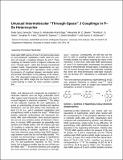Unusual intermolecular “through-space” J couplings in P–Se heterocycles
Date
20/05/2015Author
Grant ID
EP/J010510/1
EP/J501542/1
EP/F018096/1
EP/J501542/1
EP/K503940/1
EP/K031252/1
EP/K039210/1
Metadata
Show full item recordAbstract
Solid-state NMR spectra of new P–Se heterocycles based on peri-substituted naphthalene motifs show the presence of unusual J couplings between Se and P. These couplings are between atoms in adjacent molecules and occur “through space”, rather than through conventional covalent bonds. Experimental measurements are supported by relativistic DFT calculations, which confirm the presence of couplings between nonbonded atoms, and provide information on the pathway of the interaction. This observation improves the understanding of J couplings and offers insight into the factors that affect crystal packing in solids, for future synthetic exploitation.
Citation
Sanz Camacho , P , Athukorala Arachchige , K S , Slawin , A M Z , Green , T F G , Yates , J R , Dawson , D M , Woollins , J D & Ashbrook , S E 2015 , ' Unusual intermolecular “through-space” J couplings in P–Se heterocycles ' , Journal of the American Chemical Society , vol. 137 , no. 19 , pp. 6172-6175 . https://doi.org/10.1021/jacs.5b03353
Publication
Journal of the American Chemical Society
Status
Peer reviewed
ISSN
0002-7863Type
Journal article
Description
The authors are grateful to EPSRC for financial support (EP/J010510/1, EP/J501542/1, EP/F018096/1) and the award of a studentship.Collections
Items in the St Andrews Research Repository are protected by copyright, with all rights reserved, unless otherwise indicated.
Related items
Showing items related by title, author, creator and subject.
-
Controlling the electromagnetic proximity effect by tuning the mixing between superconducting and ferromagnetic order
Stewart, R.; Flokstra, M. G.; Rogers, M.; Satchell, N.; Burnell, G.; Miller, D.; Luetkens, H.; Prokscha, T.; Suter, A.; Morenzoni, E.; Lee, S. L. (2019-07-12) - Journal articleWe present low-energy muon-spin rotation measurements on Cu/Nb/AlOx/Co thin films that probe the newly described electromagnetic (EM) proximity effect. By varying the thickness of the insulating AlOx layer we control the ... -
Switching on electrocatalytic activity in solid oxide cells
Myung, Jaeha; Neagu, Dragos; Miller, David N.; Irvine, John T. S. (2016-09-22) - Journal articleSolid oxide cells (SOCs) can operate with high efficiency in two ways—as fuel cells, oxidizing a fuel to produce electricity, and as electrolysis cells, electrolysing water to produce hydrogen and oxygen gases. Ideally, ... -
Synthesis of the natural product descurainolide and cyclic peptides from lignin-derived aromatics
Ojo, O. Stephen; Nardone, Brunello; Musolino, Stefania Francesca; Neal, Andrew; Wilson, Liam; Lebl, Tomas; Slawin, Alexandra Martha Zoya; Cordes, David Bradford; Taylor, James Edward; Naismith, James H.; Smith, Andrew D.; Westwood, Nicholas J. (2018-01-14) - Journal articleAlternative sources of potential feedstock chemicals are of increasing importance as the availability of oil decreases. The biopolymer lignin is viewed as a source of useful mono-aromatic compounds as exemplified by the ...

